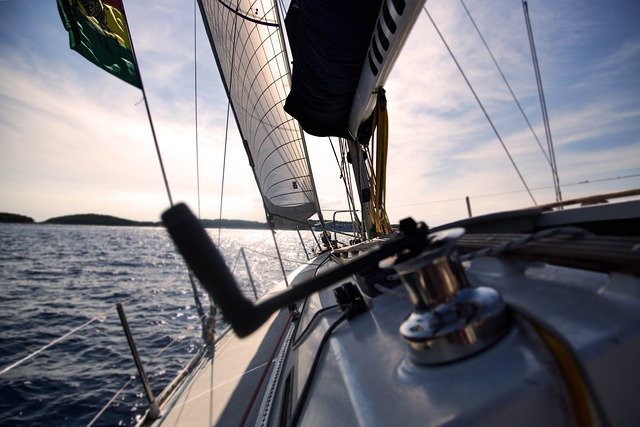Marine batteries are specialized for use on boats, differentiating from automotive batteries by withstanding harsh marine conditions. They come in two main types: SLI batteries for heavy cranking and deep-cycle batteries for prolonged power usage. When selecting a marine battery, consider the specific needs of your boat, such as powering trolling motors. Regular maintenance is key to longevity and performance; this includes terminal cleaning, preventing vibration damage, monitoring water levels in flooded lead-acid batteries, and using a marine-specific charger to avoid over/undercharging. Safety measures are non-negotiable due to the chemicals involved, necessitating personal protective equipment and a well-ventilated environment. Storage should be in cool, dry conditions, away from direct sunlight and extreme temperatures. Regular checks for corrosion or damage, securing the battery during transit, and selecting a charger that compensates for temperature are important practices to maintain your marine battery's health and efficiency. Preventative care, such as avoiding deep discharges and recharging promptly, can significantly extend your battery's life. Regular voltage checks and terminal maintenance will help you catch and resolve issues early, ensuring the safety and reliability of your vessel's power system.
explore the intricacies of marine battery care, a critical aspect of maintaining the functionality and longevity of your vessel’s electrical systems. This article delves into the various types and functions of marine batteries, offering insights on optimal charging practices and maintenance protocols to ensure peak performance. Safety is paramount when handling these batteries, and we will outline necessary precautions to prevent accidents. Temperature’s impact on battery life and performance is also examined, along with guidance on troubleshooting common issues. Marine enthusiasts will benefit from the best practices discussed to extend their battery’s life, enhancing overall boating experiences.
- Understanding the Basics of Marine Battery Types and Functions
- Optimal Charging and Maintenance Strategies for Marine Batteries
- Essential Safety Precautions When Handling and Storing Marine Batteries
- The Role of Temperature in Marine Battery Performance and Longevity
- Troubleshooting Common Issues and Extending the Life of Your Marine Battery
Understanding the Basics of Marine Battery Types and Functions

When it comes to marine batteries, understanding the basics of their types and functions is crucial for maintaining your vessel’s power systems effectively. Marine batteries are specifically designed to withstand the harsh marine environment and are different from standard automotive batteries. There are two primary types of marine batteries: starter (SLI (Starter, Lighting, Ignition)) and deep-cycle batteries. SLI batteries are responsible for cranking the engine to life, providing a short but high burst of energy. In contrast, deep-cycle batteries are designed to deliver steady power over extended periods, making them ideal for long fishing trips or cruising. They can handle frequent discharges and recharges much better than SLI batteries.
Selecting the right type of marine battery is essential based on its intended use. For instance, a trolling motor might require a deep-cycle battery due to its continuous duty over hours, while your boat’s engine might rely on an SLI battery for quick starts in various conditions. Proper care and maintenance of these batteries include regular cleaning of the terminals, ensuring they are securely fastened to prevent vibration damage, and regularly checking and topping off the water levels in flooded lead-acid batteries if applicable. Additionally, it’s important to charge the battery properly using a charger suitable for marine applications to extend its lifespan and ensure optimal performance. By understanding the types of marine batteries available and their specific functions, you can make informed decisions about which battery best suits your needs, thereby enhancing the safety and reliability of your marine adventures.
Optimal Charging and Maintenance Strategies for Marine Batteries

When it comes to maintaining your marine battery’s health and longevity, optimal charging strategies are paramount. Marine batteries, typically lead-acid or AGM (Absorbent Glass Mat) types, require regular charging to perform at their best. Charging should be done with a charger designed specifically for marine batteries to ensure the correct voltage and amperage levels are applied, avoiding overcharging or undercharging, which can damage the battery over time. It’s crucial to set up a charging routine that aligns with the battery’s usage patterns; for instance, if your boat is used frequently, the battery may need more frequent charging sessions than one that is used sporadically. Regularly check the water levels in flooded lead-acid batteries and ensure proper electrolyte concentration to maintain optimal performance. For maintenance, keep the terminals clean and free of corrosion, as this can significantly impede battery function. Additionally, store your marine battery in a cool, dry place when not in use, and avoid leaving it fully discharged or on float charge for extended periods, as this can reduce its capacity and shorten its lifespan. Proper maintenance and consistent charging with the right equipment are key to ensuring your marine battery is ready to perform whenever you set sail. Regular monitoring of the battery’s charge and state of health will help prevent issues before they arise, guaranteeing safety and reliability out on the water.
Essential Safety Precautions When Handling and Storing Marine Batteries

When handling and storing marine batteries, safety should be your top priority. These batteries, often lead-acid or AGM (Absorbent Glass Mat) types, contain sulfuric acid, which can be hazardous if not managed correctly. Always wear protective equipment such as gloves, safety glasses, and rubber boots to prevent skin contact and protect against potential spills. Ensure the work area is well-ventilated to avoid inhaling harmful fumes. Keep a spill kit on hand to address any accidental leaks or spills immediately.
Proper storage is equally crucial. Marine batteries should be stored in a cool, dry place, away from direct sunlight and extreme temperatures. These conditions can adversely affect the battery’s performance and longevity. If the battery must be charged, use a battery charger designed specifically for marine batteries to avoid overcharging or undercharging. Regularly inspect the battery and its terminals for signs of corrosion or damage during storage. Keep the battery strapped down securely to prevent movement that could cause internal damage if the battery is indeed jolted or dropped. By adhering to these safety precautions, you can ensure a safe handling and storage experience for your marine battery, thereby maintaining its efficiency and lifespan.
The Role of Temperature in Marine Battery Performance and Longevity

Marine batteries are a critical component of any vessel, providing the necessary power for start-up and operation of onboard electrical systems. Temperature plays a pivotal role in the performance and longevity of these batteries. Extreme temperatures can have adverse effects on battery life; both high and low temperatures can reduce the efficiency and capacity of a marine battery. In hot climates, excessive heat can lead to increased self-discharge rates, causing the battery to lose charge more quickly over time. Conversely, in colder environments, the viscosity of the sulfuric acid within the battery becomes thicker, reducing its ability to flow and react with the lead plates effectively. This can impede the battery’s reaction, leading to a decrease in voltage and a slower recovery after discharge. To mitigate these issues, it is advisable to install the battery in a compartment that is well-ventilated and protected from direct sunlight or extreme cold. Regular maintenance, such as keeping the terminals clean and ensuring proper ventilation around the battery, can also help maintain optimal operating temperatures. By understanding and managing the impact of temperature on marine batteries, boat owners can significantly enhance the lifespan and reliability of their power sources. It is essential to select a battery suitable for the specific conditions it will face and to employ best practices in care and maintenance to ensure peak performance throughout its service life.
Troubleshooting Common Issues and Extending the Life of Your Marine Battery

When troubleshooting common issues with your marine battery, it’s crucial to perform regular checks and maintenance to ensure optimal performance and longevity. If your marine battery isn’t holding a charge as expected, start by inspecting the terminals and cables for corrosion or loose connections. Corroded terminals can significantly reduce electrical flow, leading to poor battery performance. Additionally, check the battery’s voltage and specific gravity of each cell if accessible, to detect any imbalances or signs of sulfation, which can indicate a charging problem or overuse. Regularly cleaning terminals with a baking soda paste and carefully tightening connections can mitigate such issues.
For those looking to extend the life of their marine battery, preventive care is key. Avoid discharging the battery below 50% of its capacity frequently, as deep discharges can shorten its lifespan. Equally important is to recharge the battery as soon as possible after use, ideally within 24 hours, to prevent excessive sulfation. Storing your marine battery in a cool, dry place, and keeping it charged at around 50% during off-seasons can also protect against self-discharging and potential damage from extreme temperatures. Investing in a quality charger that offers automatic temperature compensation will further ensure the battery receives the correct charge regardless of environmental conditions. Regularly monitoring the water levels in flooded lead-acid batteries, if applicable, and topping off as necessary, will maintain the battery’s electrolyte balance, which is essential for its health. By adhering to these best practices, you can maximize your marine battery’s performance and extend its serviceable life.
When maintaining a marine battery, adherence to best practices is paramount for ensuring optimal performance and longevity. This article has delved into the critical aspects of marine battery care, from selecting the appropriate type for your vessel’s needs to understanding the impact of temperature on their function. By following the outlined charging and maintenance strategies, and by adhering to strict safety precautions during handling and storage, users can safeguard their marine batteries against common issues that might otherwise reduce their service life. With these guidelines in mind, mariners can confidently navigate the challenges of maintaining their marine batteries, thereby enhancing the safety and enjoyment of their time on the water. Remember to regularly inspect and monitor your marine battery, as preventative care is the key to a reliable power source when you need it most.
